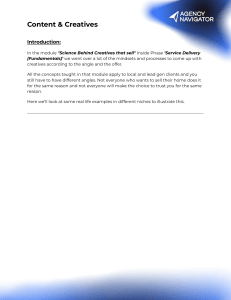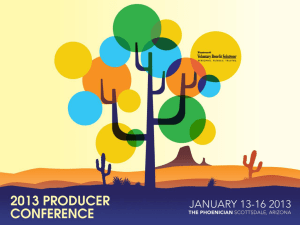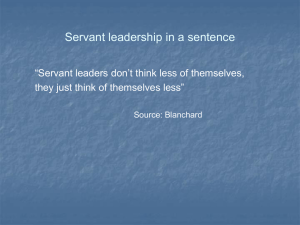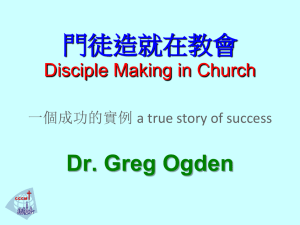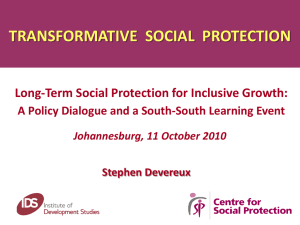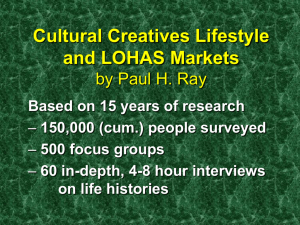Raising Peace Consciousness through Peace Education:
advertisement
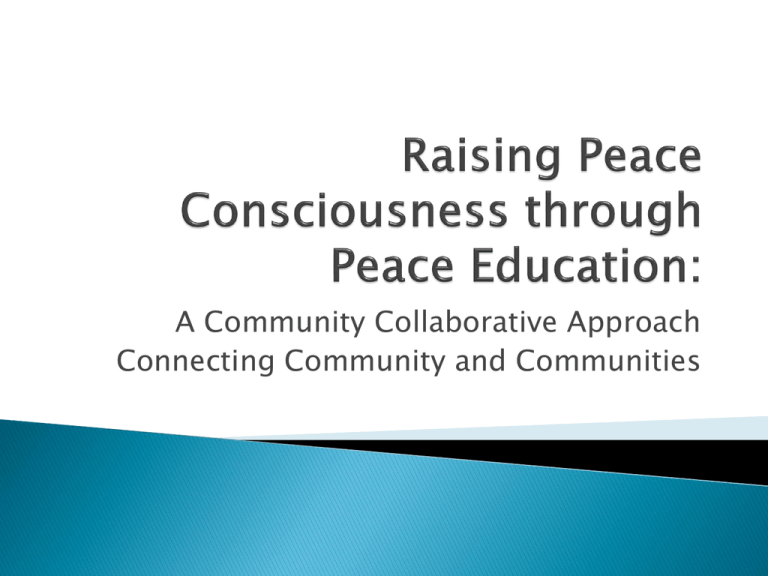
A Community Collaborative Approach Connecting Community and Communities Bob Stewart, C.A., C.M.C. Director of Canadian Centres for Teaching Peace stewartr@peace.ca www.peace.ca Making a difference A wakening A calling Finding peace Giving peace From a labour of Love to embracing the Power of Love “Be the change that you wish to see in the world”. Gandhi Peace Education = learning the skills, attitudes and behaviours to live together more successfully Personal Calling and Transformation What is in it for me? Self first vs. selfish 1. 2. 3. Peace Movements have tried 3 ways to end war: Activism Fails because protestors are not heard, outnumbered and tend to violence Humanitarianism Fails because outnumbered, outfinanced by war makers & after the fact Personal Transformation Fails because nobody has really tried it Servant Leadership & Situational Leadership http://www.peace.ca/servantleadership.htm http://www.peace.ca/peaceleader.htm Social Intelligence: How to Build Better Relationships http://www.peace.ca/socialintelligence.htm Conflict Transformation http://www.transcend.org/tpu/new/AdvPCT_all.html Transformative Communication http://www.peace.ca/difficultconversations.pdf http://www.peace.ca/crucialconversations.pdf http://www.peace.ca/crucial_confrontations.htm http://www.cnvc.org Open Space Technology http://www.peace.ca/ost.htm Macro Peace: The Big Picture http://www.peace.ca/macropeace.htm Illustration 1 (at end) – The Peace Pie, or “MacroPeace” – The Big Peace Picture (a Conceptual Map) Empowerment and Life Skills Coaching http://www.peace.ca/empowerment.htm Peace Psychology http://www.peace.ca/peacepsychology.htm http://www.culture-of-peace.info/ppa/title-page.html Spirituality For Dummies http://www.peace.ca/spirituality_for_du_mm_ies.htm http://www.peace.ca/spiraldynamics.pdf Transforming The Institutions of Religion to a Culture of Peace: The New Revelations http://www.peace.ca/conversationswithgodbook1.htm http://www.peace.ca/conversationswithgod2.htm http://www.peace.ca/conversationswithgod3.htm http://www.peace.ca/new_revelations.htm Peace Begins With Me/ Ted Kuntz http://www.peace.ca/peacebeginswithme.htm Culture of Peace Program http://www.cultureofpeace.ca Youth Driven Service Learning http://www.cultureofpeace.ca/internship.htm School Peace Programs: Model Culture of Peace in Schools (eg. Montessori) = Transformative Learning http://www.schoolpeaceprogram.org http://www.peace.ca/PARADIGMSHIFTINEDUCATI ON.doc http://www.peace.ca/educationpartnerships.htm Training the Teacher http://www.schoolpeaceprogram.org Junior Peace Achievement Psych-K http://www.peace.ca/psych-kandpeace.htm New Modalities – (MacEwen, Matrix) Sixth Senses (intuition) Healing (all relations, including earth) Transformation Teams Stress Reduction Curricula http://www.peace.ca/curricula.htm http://www.schoolpeaceprogram.org Videos http://www.peace.ca/topten.htm Our Training Videos: Overview Part 1 and Part 2 http://www.peace.ca/peaceforbeginners.htm Meditation Yoga Change Management Video - Managing the Journey (Ken Blanchard) Book - Mission Possible: Becoming a World-Class Organization While There's Still Time (Ken Blanchard and Terry Waghorn; "The significant problems we face cannot be solved at the same level at which we created them." Albert Einstein; Mission Possible offers the kind of ideas that change the world.) These two words succinctly and clearly capture the essence of the purpose of peace education and the Culture of Peace Program Social Intelligence by its nature works to change behaviours, forge values and incite institutional transformations from the current culture of war and violence to a Culture of Peace and Non-violence. Social Intelligence is readily understandable, acceptable and supportable by most Canadians. http://www.cultureofpeace.ca/CCOPPmarketingstrategy.htm The Must Read Book: www.peace.ca/socialintelligence.htm www.peacecafe.ca Building peace by connecting community through service learning in a consciousness stimulating environment. Rob Porter rob@peace-education.ca From Hamilton to Moncton Develop inventory of organizations and people in Community and area who contribute (or whose mandate contributes) to Peace at the personal, family, community, region or world levels Host Peace Café evenings at existing cafés, using local people (from inventory above) Speak to local “Meet Up Groups” provide simple advice to ‘non-card carrying’ peace supporters speak to schools Organize local high school ‘peace committees’ Develop a central resource centre help develop video assisted training Encourage/Stimulate the development of municipal peace commissions as an integral part of the city (see Hamilton example) Primary purpose is to educate, stay peaceful and help others to achieve peace. A constructive approach: Positive aims attracts Positive results. Self help with mentors = empowering Holistic Fellowship and sharing Self supporting and independent Non-controversial Neither endorses nor opposes any causes Based on broad spiritual principles Balance – finding the middle way Choices- be conscious; reclaim your power Process – taking life step-by-step Presence – living in the moment Compassion – awakening our humanity Faith – trusting in spirit Expectation – expanding our reality Integrity – living our truth Action – turns knowledge to wisdom Cycles – for every thing there is a season Surrender – embracing a higher power Unity – remembering our connection The vast majority truly wish for peace: they are willing. For those who wish to contribute but do not know what or how they can contribute, our task is to help them. This means the potential opportunity for the vast majority of human resources to be on our side (and the financial resources also). We must appeal to “what is in it for me?” – the value added to people’s lives. Our new media (computers, internet, real time television, cell phones, etc) ◦ ◦ ◦ ◦ ◦ ◦ ◦ drive drive drive drive drive drive drive new new new new new new new perceptions worldviews, understandings, psychology, relationships, institutions, culture. The most significant change that now makes peace possible is the Internet and new tech including social medias. We must use technology more effectively. Cultural Creatives is a term coined by sociologist Paul H. Ray and psychologist Sherry Ruth Anderson to describe a large segment in Western society that has recently developed beyond the standard paradigm of Modernists versus Traditionalists or Conservatists. The concept was presented in their book The Cultural Creatives: How 50 Million People Are Changing the World (2000), where they claim to have found that 50 million adult Americans (slightly over one quarter of the adult population) can now be identified as belonging to this group. They estimated that there were an additional 80–90 million Cultural Creatives in Europe as of 2000. Our mantra is “Teach Peace – Be Peace – Reach Peace”. “The most effective learning is self appropriated, self directed learning”, said Carl Rogers (noted psychologist and educator). Using ourselves as examples, we wished to make a difference with our lives and help build peace in our communities and world. This initially meant learning all that we could about peace building. We have put all that we have learned over the past 15 years onto our web sites at http://www.peace.ca (and others) so that you may learn it in a fraction of the time. We are also in the process of developing a series of videos – effectively “Everything You Wanted To Know About Peace But Did Not Know Who To Ask!” Also see “Peace For Beginners (And A Resource For The Rest Of Us)” and the related documents at http://www.peace.ca/peaceforbeginners.htm the best way to learn is to teach: the idea of teaching challenges us to refine our learning and put it into practice. We believe in the power of Service Learning (also known as Praxis). For example, we have employed numerous university students and young adults in our Peace Education Conferences and Peace Cafés – they report that they have learned more practicing peace in these settings where they organize and lead workshops than in other venues. Service Learning/Teaching to becoming a Servant Leader. A Servant Leader is a person who leads by example. http://www.peace.ca/servantleadership.htm we must model the Culture of Peace of which we speak. Otherwise no one is going to ‘buy’ what we have to ‘sell’. As Gandhi said, “Be the change that you wish to see in the world”. ‘Be The Change’ video http://www.youtube.com/watch?v=nrv3hteHglI http://www.schoolpeaceprogram.org We will change how schools are run Transforming schools and classrooms to a Culture of Peace Anne-Marie Collette amcollette@peaceeducation.ca It is everyone’s responsibility to use our discernment to choose which choices and actions are right for us (i.e. Follow your truths). As Buddha said, "Believe nothing, no matter where you read it, or who has said it, not even if I have said it, unless it agrees with your own reason and your own common sense." We are all in this together. Peace is a journey, not a destination. If we follow the Peace path, we will reach ever increasing levels of peace, love, harmony, consciousness and happiness while making a significant difference with our life and in the lives of others. It is our pleasure and honour to share the Peace Journey with you. Thank you Bob Stewart stewartr@peace.ca www.peace.ca


